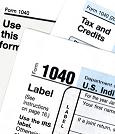 Last year I wrote about several technical issues regarding tax return filing, primarily dealing with the requirement to file a tax return in order to become eligible for the Economic Stimulus Payment (ESP).
Last year I wrote about several technical issues regarding tax return filing, primarily dealing with the requirement to file a tax return in order to become eligible for the Economic Stimulus Payment (ESP).
Unfortunately, this year is beginning with similar issues concerning tax returns.
Recovery Rebate Credit Confuses Taxpayers
First, the IRS is reporting preliminary information from early returns where 15% of filers are completing the Recovery Rebate Credit (RRC) incorrectly.
Click here to read IRS Offers Tips to Avoid Recovery Rebate Credit Confusion. Update: The Wall Street Journal picked up on these errors in a February 4 column; click here to read Early Filers Pile On Errors.
Line 70 of the 2008 Form 1040 should be used for a non-zero value for just a few scenarios:
-
Your financial situation changed dramatically from 2007 to 2008.
-
You did not file a 2007 tax return.
-
Your family gained an additional qualifying child in 2008.
-
You were claimed as a dependent on someone else’s return in 2007 but cannot be claimed as dependent by someone else in 2008.
For most filers, the Recovery Rebate Credit was previously paid in the form of the ESP (remember the IRS Economic Stimulus Payment Notice mailed in March 2008?). The ESP was $600 for most single filers and $1200 for married filing joint. An extra $300 was paid for each qualifying child of the taxpayer.
If taxpayers inadvertently list the ESP amount, say $600, on Line 70 of Form 1040, basically the credit is claimed twice, which will result in a nasty-gram from the IRS a few weeks after filing asking for their $600 back (plus a potential interest charge).
Don’t make this mistake! The IRS recommends that if there’s any uncertainty about the RRC, taxpayers should leave the line blank on the 1040. The IRS will then determine if any credit is due to the taxpayer and will automatically calculate it.
My advice: dig up the postcard that shows how much ESP was paid in 2008. If the postcard can’t be located, the IRS provides a convenient ESP lookup tool on its website.
Click here to use the How Much Was My Stimulus Payment? tool.
California Franchise Tax Board Delays Refunds
Second, taxpayers in California recently learned from the State Controller that California tax refund payments will be delayed for 30 days while the state sorts out its cash and budget shortfalls.
Click here to read the Controller’s refund delay notice.
Many taxpayers incorporate a strategy of intentionally over-withholding their payroll taxes in order to create a large refund. This “forced savings” strategy works for some who might otherwise spend the money soon after it is deposited in a bank account.
But this year, the forced savings strategy of over-withholding has backfired. Now there is a potential for a significant delay in the payment of refunds, so taxpayers who were planning for a large cash inflow come April 15 may be sorely disappointed.
Related Posts:




